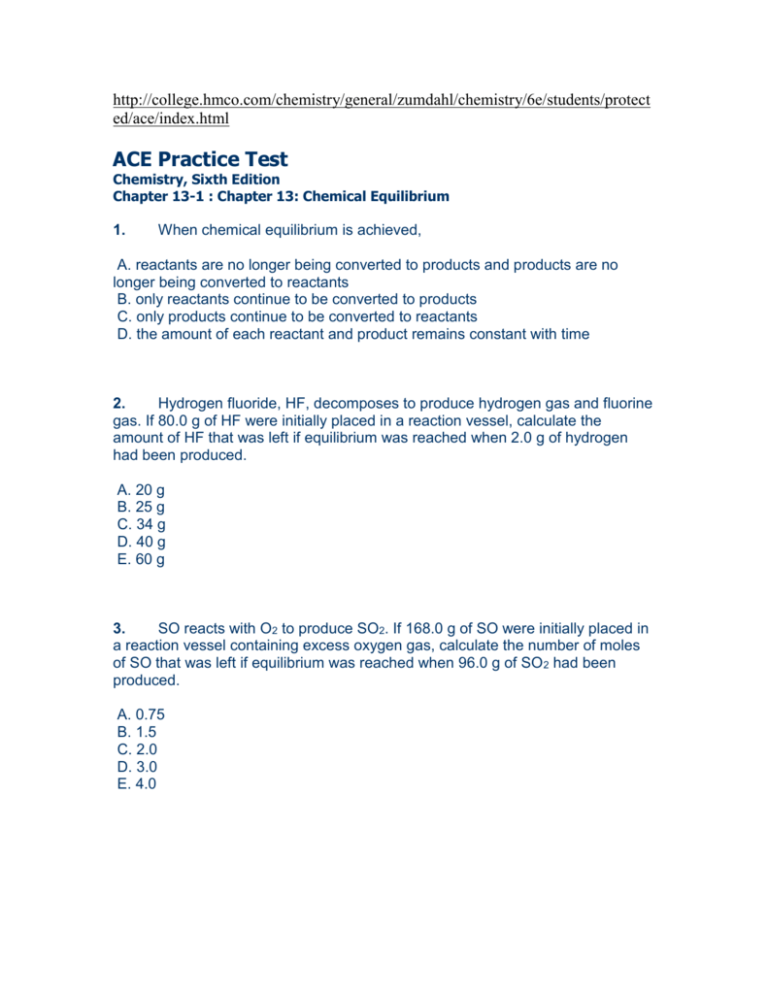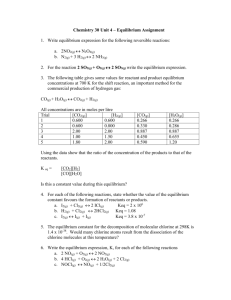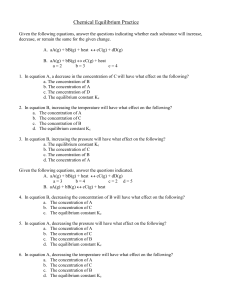
http://college.hmco.com/chemistry/general/zumdahl/chemistry/6e/students/protect
ed/ace/index.html
ACE Practice Test
Chemistry, Sixth Edition
Chapter 13-1 : Chapter 13: Chemical Equilibrium
1.
When chemical equilibrium is achieved,
A. reactants are no longer being converted to products and products are no
longer being converted to reactants
B. only reactants continue to be converted to products
C. only products continue to be converted to reactants
D. the amount of each reactant and product remains constant with time
2.
Hydrogen fluoride, HF, decomposes to produce hydrogen gas and fluorine
gas. If 80.0 g of HF were initially placed in a reaction vessel, calculate the
amount of HF that was left if equilibrium was reached when 2.0 g of hydrogen
had been produced.
A. 20 g
B. 25 g
C. 34 g
D. 40 g
E. 60 g
3.
SO reacts with O2 to produce SO2. If 168.0 g of SO were initially placed in
a reaction vessel containing excess oxygen gas, calculate the number of moles
of SO that was left if equilibrium was reached when 96.0 g of SO 2 had been
produced.
A. 0.75
B. 1.5
C. 2.0
D. 3.0
E. 4.0
4.
Which of the following expresses the relationship between the rate
constants for the forward and reverse reactions, and the equilibrium constant, for
an elementary reaction?
A. K = kfkr
B. K = kf/kr
C. K = kr/kf
D. K = kf + kr
E. K = kf - kr
5.
Calculate the value for K using the following information: kf = 2.00 x 102
M-1 s-1 and kr = 1.60 x 10-2 M-1 s-1.
A. 1.25 x 104
B. 3.20
C. 8.00 x 10-8
D. 2.00 x 102
E. 1.60 x 10-2
6.
Phosgene gas, COCl2, decomposes to produce carbon monoxide gas and
chlorine gas. Calculate the value for Kc if the equilibrium concentrations are:
[COCl2] = 0.42 M; [CO] = 0.040 M; [Cl2] = 0.040 M.
A. 0.19
B. 11
C. 0.026
D. 5.3
E. 0.0038
7.
Gaseous hydrogen and iodine react to produce HI gas. A mixture of
hydrogen gas and iodine gas are placed in a 1.00 L flask and allowed to reach
equilibrium. At equilibrium, the flask contains 0.239 g of HI, 0.254 g of I 2 and
0.00013 g of H2. Calculate the value for Kc.
A. 3.1 x 104
B. 1.7 x 104
C. 5.4 x 101
D. 1.9 x 10-3
E. 3.3 x 10-5
8.
The compound PSCl3 decomposes to produce PCl3 and S8. Calculate the
value for Kc if the equilibrium concentrations are: [PSCl3] = 1.00 M; [S8] = 9.8 x
10-5 M; [PCl3] = 7.8 x 10-4 M.
A. 1.3 x 10-29
B. 7.6 x 10-9
C. 1.3 x 10-7
D. 7.5 x 1028
E. 3.8 x 10-5
9.
For the reaction, PCl5(g) <--> PCl3(g) + Cl2(g), the value for Kc = 33.7 at
760 K. Calculate the value for Kp at 760 K.
A. 33.7
B. 2.85 x 103
C. 2.10 x 103
D. 2.13 x 105
E. 2.97 x 10-2
10.
Calculate Kp at 500°C for the reaction 4NO2(g) + 6H2O(g) <--> 4NH3(g) +
5O2(g). The value for Kc at 500°C is equal to 0.456.
A. 0.456
B. 7.19 x 10-3
C. 18.7
D. 2.19
E. 0.0535
11.
Calculate the value for Kp given the following information: N2(g) + O2(g) <-> 2NO(g); P(N2) = 0.65 atm; P(O2) = 0.065 atm; P(NO) = 0.000043 atm.
A. 4.4 x 10-8
B. 2.3 x 107
C. 1.0 x 10-3
D. 9.8 x 102
E. 3.1 x 10-5
12.
Consider the reaction N2(g) + O2(g) <-- > 2NO(g). A 1.00 L closed vessel
at 273 K contains 0.813 g N2, 0.0929 g O2, and 0.0576 mg of NO at equilibrium.
Calculate the value for Kp.
A. 125
B. 7.98 x 10-3
C. 4.38 x 10-8
D. 2.29 x 106
E. 762
13.
Cl2(g) + F2(g) <--> 2ClF(g) Kc = 6.9;
2ClF(g) + 2F2(g) <--> 2ClF3(g) Kc = 20.1;
2ClF3(g) <--> Cl2(g) + 3F2(g) Kc = ?
Calculate the value for Kc for the third reaction.
A. 0.0072
B. 1.4 x 102
C. 2.9
D. 0.34
E. 27
14.
2SO(g) + O2 <--> 2SO2(g), Kc = 8.65;
2SO2(g) + O2(g) <--> 2SO3(g), Kc = 120.0;
2SO(g) + 2O2(g) <--> 2SO3(g), Kc = ?
Calculate the value for Kc for the third reaction.
A. 0.0310
B. 32.2
C. 13.9
D. 0.721
E. 1.04 x 103
15.
In the reaction Zn(OH)2(s) + 2OH-(aq) <-- > Zn(OH)42-(aq), which
compound is not included in the Kc expression?
A. Zn(OH)2
B. OHC. Zn(OH)42D. none of the compounds is included in the Kc expression
E. all of the compounds are included in the Kc expression
16.
Write the correct equilibrium expression for the reaction Al(NO3)3(s) +
6H2O(l) <--> Al(H2O)63+(aq) + 3NO3- (aq).
A. K = [Al(H2O)63+][NO3-]3/[Al(NO3)3][H2O]6
B. K = [Al(H2O)63+][NO3-]3/[H2O]6
C. K = [Al(H2O)63+][NO3-]3/[Al(NO3)3]
D. K = [Al(H2O)63+][NO3-]3
E. K = [Al(H2O)63+][NO3-]3 / [Al(NO3)3][H2O]
17.
Which of the following is the correct equilibrium constant expression for
the reaction H+(aq) + OH-(aq) <--> H2O(l)?
A. K = [H+]/[H2O]
B. K = [OH-]/[H2O]
C. K = 1/[H2O]
D. K = [H+][OH-]/[H2O]
E. K = 1/[H+] [OH-]
18.
For the reaction PbCl2(s) <--> Pb2+(aq) + 2Cl-(aq), the equilibrium
concentration of Pb2+ is found to be equal to 0.025 M. Calculate the value for Kc.
A. 6.3 x 10-5
B. 0.025
C. 6.3 x 10-4
D. 1.6 x 10-5
E. 1.6 x 10-1
19.
Carbon reacts with O2 to produce CO according to the equation C(s) +
O2(g) <--> 2CO(g). When 0.25 mole of O2 is added to carbon in a 500-mL
container, the equilibrium concentration of CO is found to be 0.19 M. Calculate
the value for Kc.
A. 0.39
B. 0.089
C. 0.15
D. 0.023
E. 1.5
20.
Kc for the dissociation of pure water into protons and hydroxide ions is
equal to 1.00 x 10-14. At equilibrium, pure water
A. contains mostly undissociated water molecules
B. contains a nearly equimolar mixture of water molecules, protons and
hydroxide ions
C. contains mostly protons and hydroxide ions
D. contains no protons or hydroxide ions
Submit Quiz
Site Map I Partners I Press Releases I Company Home I Contact Us
Copyright Houghton Mifflin Company. All Rights Reserved.
Terms and Conditions of Use, Privacy Statement, and Trademark Information








